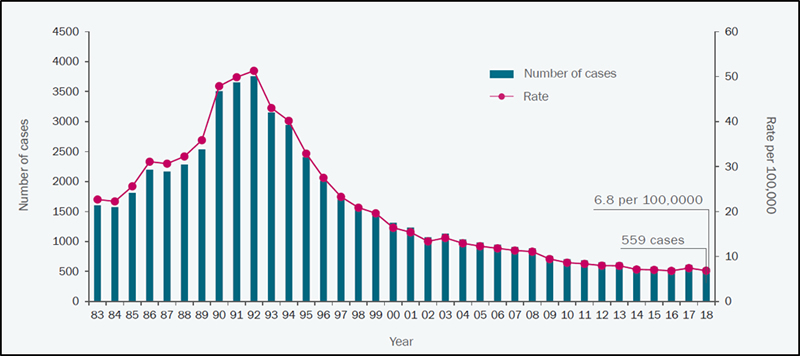TB Rate High in Western Queens Despite Citywide Decline
/Tuberculosis cases and rates in New York City from 1983-2018. Graph courtesy of the NYC Department of Health
By David Brand
The rate of tuberculosis diagnoses in Western Queens outpaces the rest of the city, even as the TB rate has declined overall, according to data published the Department of Health on Monday.
Roughly 37 percent of the 559 New Yorkers diagnosed with TB in 2018lived in Queens, the borough with the most diagnosed TB cases. The potentially fatal illness is an airborne bacterial infection that primarily affects the lungs and causes severe coughing, fever and loss of appetite.
About two-thirds of the city’s TB patients were born in China, the United States, Ecuador, Mexico and India, according to the New York City Department of Health. Immigrants accounted for 84 percent of the new cases.
"As TB continues to disproportionately affect people born outside the United States, it is important that residents have the confidence to get tested and treatment,” said Flushing Councilmember Peter Koo. “These services are available regardless of status, coverage or medical history.”
New York City Health Commissioner Dr. Oxiris Barbot advised New Yorkers who have had a cough lasting more than three weeks or who have spent time around someone with TB to visit one of the city’s four Chest Centers for free treatment. Queens’ chest center is located at 44-33 Junction Blvd. in Corona.
The Brooklyn chest center is located at 295 Flatbush Avenue Ext. in Fort Greene.
“Following the rise in tuberculosis cases that we saw in 2017, we are pleased to see our case count decline. This success is a credit to the Health Department’s TB prevention and control efforts,” Barbot said. “West Queens and Sunset Park, Brooklyn continue to see high rates of TB diagnoses.
Sunset Park had the highest rate of TB diagnoses in the city at 17.9 cases per 100,000 people, more than double the citywide rate.
Despite the 8 percent decline citywide, the rate of TB diagnoses among New York City children rose by 28 percent from 18 cases in 2017 to 23 cases last year. Adults over age 65 also experienced a 12 percent increase in TB diagnoses, from 146 cases in 2017 to 164 in 2018.
Sunday, March 24 is World TB Day, which commemorates the discovery of the bacteria that causes TB in 1882 by Dr. Robert Koch. About 9 million people around the world contract active TB each year, though a cure was developed in the 1940s. TB kills nearly 4,500 people die per day, the UN reports. More than 1 billion people around the world have latent TB, which does not cause sickness because their immune system can resist the bacteria, according to the American Lung Association.
After several decades of declining TB rates, the illness surged in New York City during the HIV/AIDS epidemic of the 1980s. HIV and AIDS erode an individual’s immune system, leaving them vulnerable to the opportunistic TB bacteria.
TB still accounts for a third of AIDS-related deaths around the world, the World Health Organization reports.
The threat of TB, and the historic rise in diagnoses that corresponds with HIV/AIDS diagnoses, helps inform the state and city effort to eliminate HIV.
“Despite recent laudable progress, TB's decline is still too slow. TB continues to disproportionately affect New Yorkers of color, poor New Yorkers, and those born outside of the U.S., and increases in some of the most vulnerable groups--children, and people over 65 — are worrisome,” said Mark Harrington, executive director of the Treatment Action Group. “A concerted prevention effort that uses the latest scientific developments, and engages communities, can change this. New York has been a leader on ending HIV and Hepatitis C, it's time for us to also commit to ending their deadly co-infection, TB."




